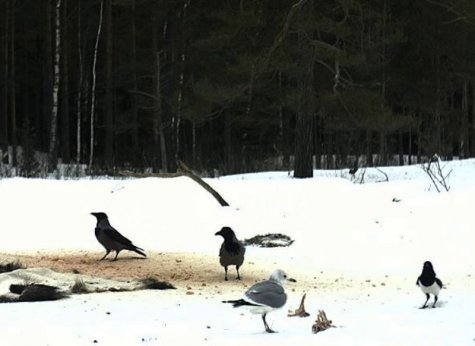Common gull in uncommon environment
Text: Kalev Rattiste
Webcamera image: Mutikluti from the LK forum
Looduskalender asked Kalev Rattiste who has studied the mew or common gulls for decades for a comment:
Common gulls should mostly be in their wintering areas; what are the birds that winter at our coasts doing at the moment and how did this bird happen to end up at the feeding ground of the white-tailed eagles?
Of the common gulls that breed on the Matsalu islets, the adult birds leave immediately after the nesting period and head straight for their wintering areas. Towards the end of July we can already meet them in the Netherlands and southern England. Most of our common gulls spend their winters in the Netherlands, Denmark and Germany, a smaller group in southern England and northern France. In the beginning of the 1960ies the winters in western Europe were particularly severe and then our common gulls were found even in southern France and Portugal.
Common gulls are very true to their wintering area – year after year the winter is spent in the same spot (for instance the free port in Copenhagen or in Amsterdam, the Erasmus Park). A record of its kind was set by the male gull with the plastic ring P856, who was observed for eight winters in a row in the city of Bremen, altogether 142 times. Breeding partners migrate and spend the winter apart from each other; they meet again in spring at the nesting site.
Juvenile birds will not fly to the wintering area with their parents but instead drift around quite widely in autumn. Sometimes they get further away from the wintering area during these journeys, for instance in Finland and Russia. Because of this they of course also arrive later to the wintering area.
In autumn numerous common gulls from other countries pass through Estonia. In certain autumns hundreds of common gulls can for instance be seen on the roof of Tartu’s Lõunakeskus, securely resting there.
A small group of the common gulls spend their winter at sea in the eastern part of the Baltic. Where they come from is not known precisely. But one common gull ringed in Estonia comes to mind: it was found in the winter in the Gulf of Riga. This winter too the common gulls in the Gulf of Finland and around Hiiumaa follow the fish trawlers. These gulls stay around the fishing boats in the open sea. Kert Rannaste, one of our most diligent gull ringers, told yesterday that around his vessel there were more than 160 gulls, mostly common gulls, with just a few herring gulls. Kert has managed to capture and check about a hundred common gulls. Among the captured birds have been those with rings from the Netherlands, Sweden and also Finland. Where and when and in what circumstances (nestling, winterer) these birds were ringed will be clear when the answers arrive from the ringing centres of the respective country. One gull had an Estonian ring and had been ringed two years ago by Kert himself near Paldiski.
With strong winds the common gulls wintering at sea may end up in the mainland The common gull at the eagle feeding ground had probably arrived in the Peraküla area with strong storm winds, and then located the feeding place by observing other birds (crows and ravens).
In winter common gulls look quite different from the nesting period in spring. The bird that strayed to the eagle feeding ground was no juvenile (they are wholly greyish-brown) but an adult bird. The head and neck, beautifully white in spring, are now speckled, the yellow beak has changed to brownish / bluish with the tip broadly black, and the feet too are noticeably darker.
***
Author Kalev Rattiste, researcher at the Estonian University of Life Sciences, presented his thesis, Life history of the common gull, (Larus canus), A long-term individual-based study” at Uppsala University, Sweden, in 2006, full text available here









